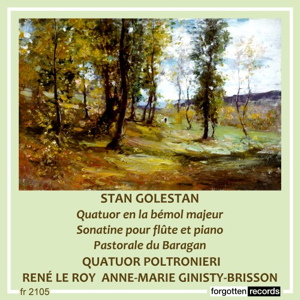
Stan Golestan (1875-1956)
String Quartet in A flat major (1927)
Flute Sonatine (1932)
Pastorale du Baragan; Doïna dans le caractère Populaire Roumain (1934)
Poltronieri String Quartet
René Le Roy (flute) and Anne-Marie Ginisty-Brisson (piano)
rec. April 1929, London (Quartet); April 1936, Studio Albert, Paris
Forgotten Records FR2105 [45]
Stan Golestan was a Romanian composer born in Vaslui but the cultural affinity that existed between Romania and France saw him study in Paris between 1895 and 1903, where his teachers included such small fry as d’Indy, Roussel and Dukas. These were the best possible compositional models for an aspiring composer but Golestan was also, and perhaps predominantly, better known as a journalist and critic for Le Figaro. Doubly equipped, he was able to write music without being endangered by impoverishment.
One of his best pieces is the First String Quartet of 1927, which was recorded two years later by the Poltronieri Quartet during one of its visits to Britain. The members of this quartet were certainly not unknown to some British listeners. On its visits it had already recorded Boccherini and – adventurously – Malipiero’s Second Quartet for the National Gramophonic Society (NGS), subscription discs released under the auspices of The Gramophone magazine. Shortly after recording the Golestan, they recorded Borodin’s Quartet in D major, Dvořák’s American and other pieces. Golestan’s quartet is a charmingly balanced work, exuding antique-sounding cadences, romanticised allure, fugal development – malleably deployed – and attractive folksy drive. The most exotic music comes in the central Scherzando where some Romanian-infused music and pizzicato-flecked writing carries with it lashes of vocalised and conversational colour. Impressionism, occasionally part of Golestan’s armoury, surfaces in the finale, as well as a sense of pathos couched in the vocabulary of lightly modernist French tradition. The work ends quietly in a satisfying arch.
Though there is some turntable rumble it’s compensated for in a forward, bright and very vivid sounding transfer. Side joins are imperceptible.
Seven years later René Le Roy and Anne-Marie Ginisty-Brisson recorded Golestan’s Flute Sonatine, a brisk thirteen-minute work in four movements composed in 1934. It fuses a light and airy Allegretto with a perpetuum mobile second movement, a warmly liquid slow movement and finally a refined, energetic finale. It’s a polished, clean work in the best French wind style. They also play the Pastorale du Baragan, a filler to the sonatine. Despite its subtitle ‘Doïna dans le caractère Populaire Roumain’, it’s lightly burnished and not the Enescu-influenced folk fest you might be expecting. These French HMVs are also very attractively transferred.
No notes, as is usually the case with Forgotten Records, but there are a few internet links.
This label doesn’t issue many transfers of 78s but when it does it selects perceptively and attractively.
Jonathan Woolf
| Availability |  |


















